
E. M. Bazelyan, DEA, professor;
Power Engineering Institute to the name of G.M. Krzhizhanovsky , Moscow;
recognized Russian expert in the field of grounding and lightning protection.
Lightning orientation mechanism
Calculations of efficiency of lightning arresters are one of the most essential and common in the lightning protection. A probability of lightning breakthrough to the protected facility is determined and boundaries of the area near the lightning arrester are defined wherein a number of lightning strikes does not exceed the allowable number within a specified operating period. You can also use a concept of protection reliability by calculating a fraction of lightnings to be caught by the lightning arrester. All of these parameters are actually different quantitative estimates of the result of the same process known as lightning orientation.
Physical ideas of lightning orientation have been developed to a sufficient degree and do not cause any particular doubts. The main actor is an opposed leader. It starts from the top of the on-ground facility (e.g. lightning arrester) in a storm electrical field and is formed opposite to the lightning channel, i.e. its downward leader. When these conductive plasma channels meet, they essentially define the lightning strike point thus pre-defining its destructive current path.
A rather simple process scheme shows statistically widely varying parameters. First, it is a storm field of the atmosphere. It is defined by a thundercloud charge and the charge of the downward lightning leader. The latter is the most important. It stimulates a rapid growth of the field near the lightning arrester and the facility required to emerge and develop the opposed leader. The lightning charge varies widely, and range of its statistical dispersion is not less than the order of magnitude. The electrical field of this charge varies even more greatly. Even with the fixed charge, it varies depending on the unpredictable lightning path and on its growth rate to the ground surface. Also, an emerged opposed leader path also seems undefined.
Actually, we should not talk about a single channel. Usually, during the lightning development, several of them appear from various points, e.g. from the lightning arrester and from the protected facility. The problem is in the analysis of their competitive development since ultimately only one of them will meet an opposed leader and catch the lightning. This process is especially significant for the practice. It is clear from the qualitative point of view but it is only generally described quantitatively.
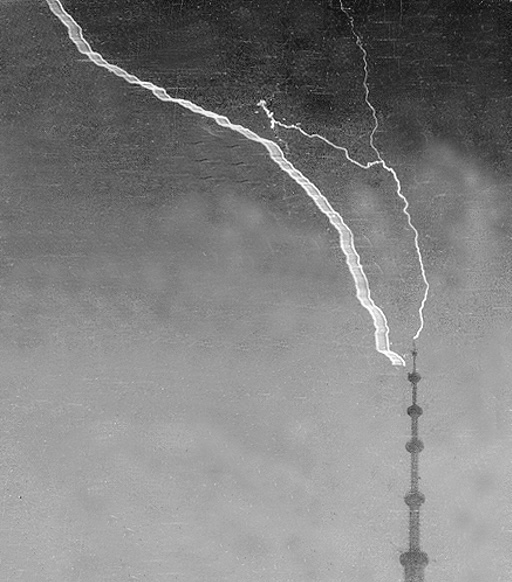
Opposed leader coming from the TV Tower top was late
Surely, we would have had to generate an estimation computer model by analyzing all of the above statistically. Unfortunately, there are no reasonable initial data for this, and there is also no possibility to convert even already developed calculation software into a working tool for a design engineer who should calculate lightning arresters almost every day.
Background
For a sequential disclosure of events, we have to get back to the times of B. Franklin and M. Lomonosov, remember a tragic death of G. Richter in 1753 and consider with a deep respect the following description of his death: "Richter died beautifully when fulfilling his job's responsibilities. Memory of him will never die." It is necessary that "this case would not be interpreted against the science". This is what our fellow countryman M.V. Lomonosov wrote to Count Shuvalov in his letter.
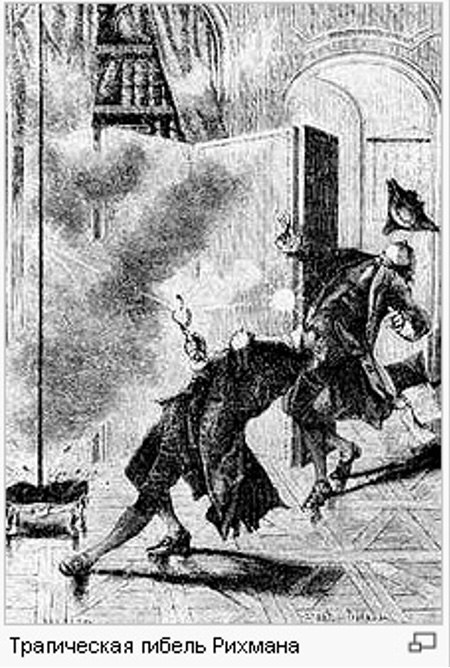
An old-time engraved plate
The electrical nature of the lightning did not cause any doubts anymore. In those years, a lightning arrester was invented (more precisely, "a storm arrester" as it was known back then). First, the issue of lightning attraction was not discussed at all.
Now, the story can move to the 20th century without any losses. It was then when high-voltage pulse sources (PVG) appeared which are capable of generating spark charges of several meters long. Permanently functioning lightning model appeared in the laboratory. Nobody had a doubt in full analogy between a long spark and a lightning. Then, an issue of small-scale simulation of the orientation process emerged. Sparks of several meters long were used to attack the lightning arrester and protected facility models. The number of breakthroughs to the facility, passing the lightning arresters, was precisely recorded. Thus, using different elevations of the lightning protection models above the facility and different distances from each other, the lightning protection zones were determined. In our country, the first research were conducted in VEI (A.A. Akopyan) and ENIN (I.S. Stekolnikov). To generate protection zone boundaries according to the obtained experimental data, various empirical formulas were proposed. Usually, curves of the second order or simply straight lines were used. Their analysis can hardly make sense today. But one essential fact should be noted. The boundary of those first protection zones projected from the lightning arrester's top. In other words, it was supposed that the lightning could see even an infinitely small elevation of the lightning arrester above the protected facility and always followed the shortest path.
There were no particular doubts in the latter aspect. In those years, to simulate the lightning, the so-called standard storm pulse having the front of 1.2-1.5 mcs and the tail of 40-50 mcs was used. Measurements of breakthrough voltages upon the exposure of such pulse differed in a small (about 1%) dispersion and not really curved paths. Later on, even the so-called electrogeometrical method was created which allows calculating lightning distribution among lightning arrester, ground, and protected facility. It was supposed that the lightning does not respond to the ground surface state up to a certain height. At this height (it was called the orientation height), the lightning has an equal probability of appearance at any surface point. After that, the lightning unambiguously chooses the shortest path by comparing distances to the lightning arrester, to the facility, and to the ground surface.
In the western countries, the electrogeometrical method still holds some interest. The trade is only about the orientation height value. To improve the method, various dependencies of this parameter and the height of on-ground structures and the lightning current are attempted to be introduced. In the course of my significant work experience in lightning protection, the orientation heights changed almost 2-fold.
Probably, theoreticians unjustifiably neglected experimental capabilities of the laboratories where serious changes have taken place over recent decades. First in our country, and then in the laboratories of other countries, the researchers began studying a spark discharge in the air with voltage pulses having a shallow (about 100-1,000 mcs) front, which allows to more precisely reproduce changes in the electrical field of the atmosphere over time upon the lightning formation. Experiments have shown that the electrical strength of the air may drastically reduce upon such exposures; but the most essential point is that they increase the dispersion of breakthrough voltages by about an order of magnitude. As a result, uncertainty of long spark paths has increased significantly.
A photo shown in the figure was obtained at the end of the previous century by the specialists of SibNIIE on an open-type high-voltage bench. The spark ignored a direct path 34 m long from the PVG top to the ground, and moved towards the path about 150 m long.
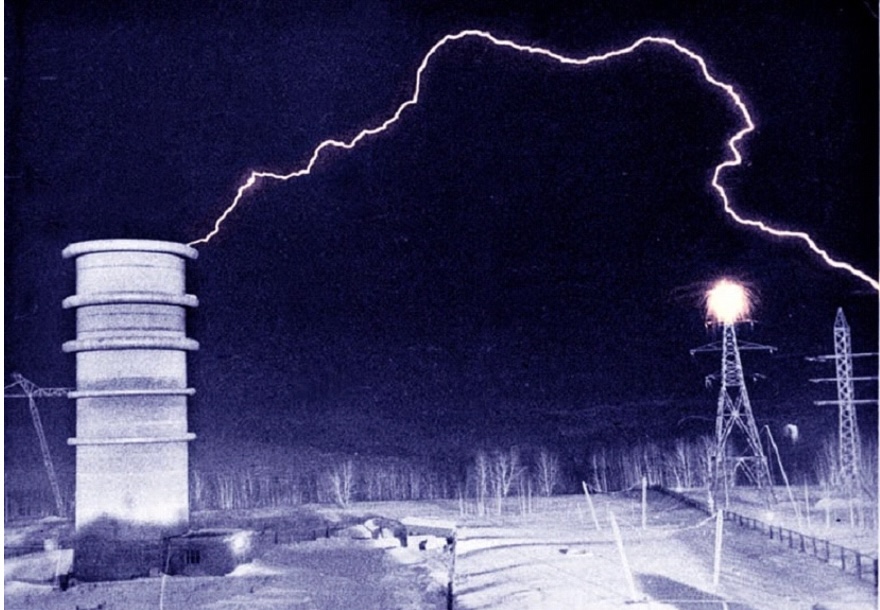
A convincing example of long spark path dispersion
Today, the situation shown in the photo cannot be considered unique. Something similar was also observed on other open-type high-voltage benches.
The modern laboratories allow assessing the capabilities of the orientation process simulation by using a long spark as a lightning model. Unfortunately, the results of such research did not prove to be very optimistic. They were performed on an open-type LPI bench under cooperation between ENIN and this institute using a very original technique. It is very effort-consuming but simple and deserves attention.
In an absolutely symmetrical gap of "rod-plane", many hundreds of spark charges are photographed. They follow various paths. None of them may be predicted in advance. However, all directions of spark development in a symmetrical gap are equally probable. If we process every photo by summing up horizontal deviations in the photo plane considering the sign (e.g. the right ones are with a plus sign, while the left ones are with a minus sign), the total deviation for each path height will be identically equal to zero. As a result, generalized path is a vertical line. This is what was obtained on an open-type high-voltage bench site.
Now, on the ground surface a side-shifted rod electrode is installed. The symmetry is distorted. It will affect the total path when a downward leader will "feel" the created asymmetry and respond to it. Several dozens of thousand measurements in the gaps of 0.5 to 12 m were performed. This was a hard and exhausting job. Here are the results:
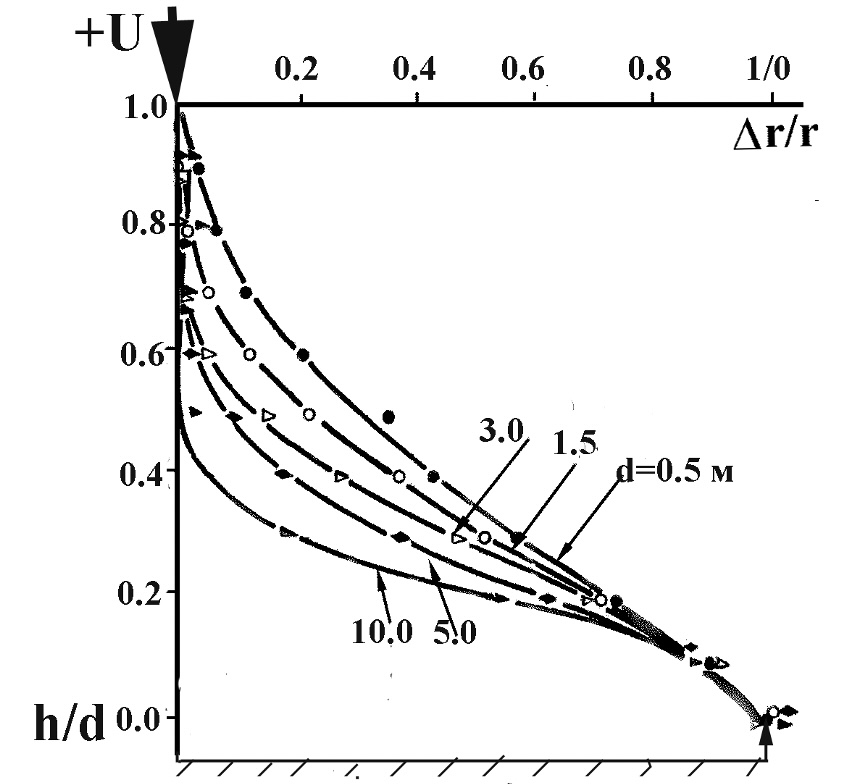
Estimation of the long-spark leader orientation height
You can see that the result of modelling in laboratory heavily depends on the model scale. There's almost no generalized path in a short gap of the vertical section. It means that the orientation process of the spark channel begins from the start. In a 10-meter gap, the leader does not respond to the ground surface state until it goes down to the height 0.5h, and only then orientation starts. In other words, laboratory simulation is ambiguous and is therefore unable to give a particular answer to the question of quantitative estimation of the protective action of lightning arresters. However, the experiments with differently sized models are still in use, as they say, for quality estimates. But quality estimates
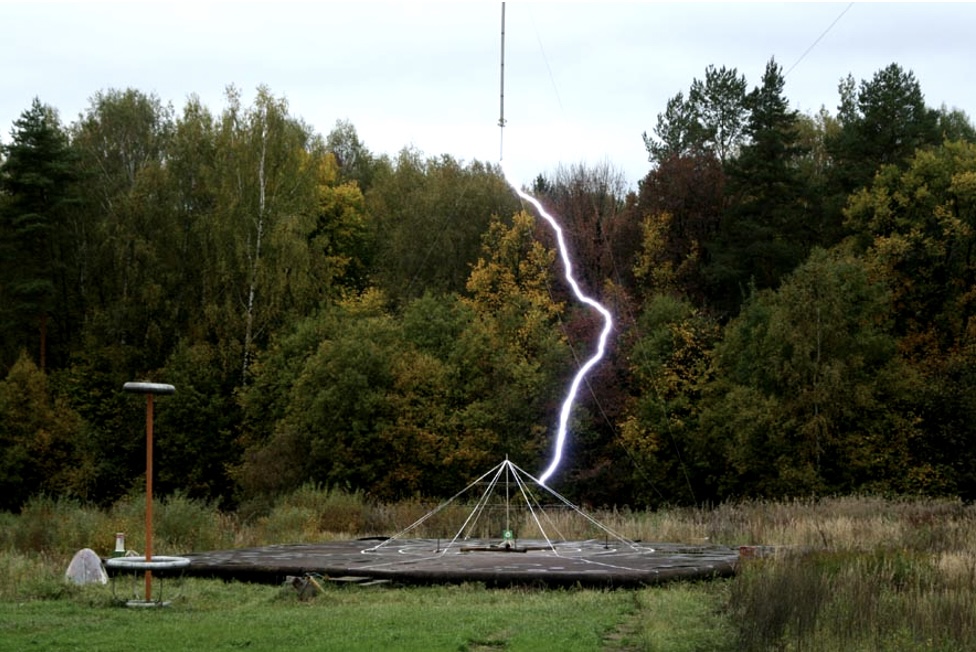
It’s being simulated until the present
are not enough for the designer. A precise calculation of the facility protection reliability is required for any configuration of a random system of lightning arresters. This is the task to be solved. It is clear that the result of a small-scale laboratory experiment can hardly be used in this case.
What should we do?
This is a typical issue, and for the Russian citizens, it is not only in lightning protection. It is clear that you cannot make it using a general approach. You need particular answers but, anyway, it is worth using the disclosure of the most general principles for the problem solution. It is worth formulating these principles.
After the performed analysis of capabilities of the laboratory experiment, the specialist's toolkit contains nothing more but the operating experience.
Another height-limiting point was obtained on the Ostankino TV Tower where representative statistics for the storm activities were received. Thus, the specialists could collect the factual material which is sufficient at least for linear extrapolation of the operating experience to the facilities of various heights. Now, a primary issue involves a methodological basis for the calculation model generation.
Based on observation of lightning and long spark, it is clear that the model cannot be determinate, similarly to the electrogeometrical method, where the lightning strike point is unequivocally predetermined by dimensions. On the contrary, the model should represent a statistical nature of the spark discharge, according to which upon the supply of voltage to the gaps of various lengths, any of them may be broken through with a particular probability rather than only the shortest and the weakest gaps. Representation of a statistical nature of a long spark and lightning seems to be absolutely necessary.
Precise consideration of one more principal condition is no less important. Spark channels from the facility, the lightning arrester and from the ground surface may affect each other via electrical fields. The degree of such influence depends on the distance between the discharge gaps where these discharges are formed. In case of a close location, influence through an electrical field may be very strong. Then, a sudden change of development conditions of an "especially successful" opposed discharge becomes almost predefining. Upon the distance increase, the mutual impact becomes weaker and can ultimately be neglected. Mutual influence of opposed discharges should also be considered in generation of the estimate model.
In the simplest case, the model contains three discharge gaps simultaneously connected to a common source of high voltage. The downward lightning leader channel is their common electrode, while lightning arrester, protected facility, and ground surface are electrodes having an opposite polarity. The computer model should determine the probability of a breakthrough for each gap. Thus, the number of strikes to the lightning arrester and to the facility within a specified operating period will be established and (if required), the protection reliability and the probability of the lightning breakthrough to the protected facility.
In a statistical technique disclosed herein, the task is reduced to estimation of the breakthrough probability of the system consisting of the above air gaps, simultaneously connected in parallel to a common voltage source. It is considered that the breakthrough voltage of each voltage is subject to statistical dispersion. According to the laboratory experiments performed in long air gaps, it is assumed that the breakthrough voltage dispersion meets the normal probability law with a high accuracy. For two discharge gaps with average breakthrough voltages U1 и U2 and dispersion standards σ1, σ2 in case of ignoring the mutual impact, the breakthrough probability for any gap, e.g. the first one, will be equal to the probability of meeting the inequality:
∆U р21 = Uр2 – Uр1 > 0
(1)
For normal distribution of current values of breakthrough voltages of gaps Uр2 and Uр1 their difference ∆Uр21 also meets the normal probability law, wherein the average value of this parameter is equal to the difference of average values
∆U21 = U2 – U1
(2)
and dispersion standard σ∆U is to be determined as follows:

(3)
As a result, the breakthrough probability of the gap Ф1 to be found can be expressed by using a tabulated probability integral:

(4)
where
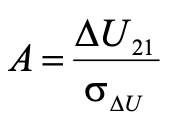
(5)
In the event sequence considered above nothing more has been used except for the formal apparatus of theory of probability. All recorded relations are equally suitable for estimation of probability of any pair of events, if they are independent (have no mutual influence), and the end of one of them eliminates the end of another.
In a developed statistical technique, it is assumed for quantitative description of the process of determination of the lightning strike point that a real event track is conditionally divided into two estimation steps. First of them (during orientation) determines the probability of the lightning strike to the "lightning arrester-facility" system rather than to the ground surface. Here, distances between the start points of the opposed leader are rather large; therefore, you can disregard mutual influence through an electrical field, literally using the system of equations (1)-(5). In the second process (choice process) ), the issue of distribution of already oriented lightnings between lightning arresters and the protected facility is solved. Usually, they are rather close to each other. However, the system of equations (1)-(5) can also be used in this case considering mutual influence between the charges by introduction of the respective adjustment coefficients.
As a result, the quantitative description of the result of orientation Ф(r) and choice M(r) processes is reduced to the calculation of typical expressions based on probability integral (5) with various values of its upper limit (6).
The appendix is provided hereto to detail the procedure. The text was written for those who are especially interested in the topic. Even if you think of using software, it is not required to read this text. Here, it is sufficient to note that the production of orientation F(r) and choice M(r) probabilities sets the probability of the lightning breakthrough to the protected facility bypassing the lightning arrester from the point having coordinate r in the orientation plane. To determine a complete expected number of lightning breakthroughs to the protected facility, you should integrate this production along the entire plane since the appearance of the lightning in any of its point has an equal probability. Then, the integration result should be multiplied by the density of storm discharges for this location nM. In the simplest case, in case of the presence of radial symmetry,

A set of provided formulas can be extended to any arbitrary complex system of lightning arresters and facilities, if we are using the shortest distances to the ground, to the set of protected facilities and to the set of lightning arresters. In this case, both the protected facilities and the lightning arresters protecting them may be of any random shape and size, and the shortest distances themselves and the point locations in the grounded system according to which they are determined, will depend on the lightning leader head coordinates x, y in the orientation plane.
All of the above was implemented in the calculation software, publicly available on the ZANDZ website.
In its general form, the method is recommended for use by Technical Circular No. 25/09 of the Electromontazh Association with approval of Gostekhnadzor.
How to consider protection zones?
Before answering this question, it makes sense to clarify the origination of the protection zones included in the Russian regulatory documents RD 34.21.122-87 and SO-153-34.21.122-2003. It is not a secret today that all of them are calculated using a statistical technique described herein. Unfortunately, in the older standard, there are no particular protection reliability values defined for the zones. Only a designation is used: zone A and zone B. The later explanatory article states that the zone A protection reliability is close to 0.995, and zone B is close to 0.95. Both are calculation errors. The control check has showed
Moreover, RD 34.21.122-87 proposes without any reasons the method for evaluation of the protected effect of repeated lightning arresters which are not recommended for use, and protection zones for high-rise lightning arresters have been generated with serious mistakes.
These mistakes were corrected in SO-153-34.21.122-2003. Lightning arrester protection zones have got protection reliabilities which were determined reliably. The provided empirical formulas for calculation describe single and double rod as well as wire lightning arresters up to 150 m high. All of these are suitable for design practice. However, when using protection zones for selecting lightning arresters, the designer should consider that the obtained result nearly always leads to overestimation of the lightning arrester height. The reason is that the boundary of the protection zone is determined by statistical technique for the hardest case when the entire protection zone volume is filled with a protected facility. In practice, this almost never happens. It is important to consider that the zones do not provide for the selection of repeated lightning arresters, and their heights are dramatically less than of single and double arresters. It's not worth comforting yourself that steel structures are cheap. The point is not only in savings of metal, which does not really matter, or is even non-existent. The installation of high-rise lightning arresters attracting lightning from a larger area complicates extremely the provision of electromagnetic compatibility with the lightning, because such lightning arresters are a source of additional electromagnetic interference which are very dangerous for the modern smart equipment.
I advice to avoid using protection zones and try to use the existing software.
What can the software do?
This is an important question because the user is very interested in the functionality of the software. The service functionality does mean for them at least the same as an underlying ideological basis. Not without a reason, e.g. a rolling sphere method is widely used in the IEC standard. It is as simple as an apple, and all other points are not very important for an ordinary user (we will have to get back to the problems associated with the rolling sphere method later).
Height and configuration of the considered facilities in the software are almost unlimited in terms of numbers or shapes. We are talking about any on-ground facilities. Their purpose does not matter. Each structure entered into the software has an assigned purpose: whether it is a lightning arrester or a protected facility. The software allows changing any purpose easily. E.g., the production building of the plant can be designated as a protected facility, and we can calculated the number of lightning breakthroughs for it. And then, in the next calculation option, we can designate only climate control units located on the building roof as a protected facility and find the expected number of breakthroughs for them particularly. This is very convenient.
Configurations of on-ground structures are not limited. The software uses a Lego principle. Rods, wires, rectangular structures, cylinders, hemispheres, triangular pyramids can be used as structural elements. Any on-ground structure can be collected from these elements. The structural elements may have any size and be located on the ground or above each other. To provide reliability, it is necessary that the real-life structure fits the assembly.
The user manual does not recommend calculations for structures above 200 m, since upward lightnings are typical for them, which have a different physical nature in terms of choosing the strike point.
The calculation results contain a full set of parameters required to calculate the lightning protection reliability. They include a total number of lightning strikes to the lightning arrester system: facilities for the entire storm season, expected number of lightning breakthroughs to the protected facility, breakthrough probability, and protection reliability. If desired, the user can get a number of lightning breakthroughs to any particular structural element of the facility or the number of strikes to a particular lightning arrester to assess the suitability of its use.
The maximum protection reliability is not limited by methodology. However, the operating experience has no reliable actual data on the lightning breakthrough probability lower than 0.001. For this reason, the protection reliability exceeding 0.999 cannot be considered reliable.
What do they use in the West?
The answer is provided by IEC 62305. It rates the calculation and choice of lightning arresters in the European countries. Too bad, the document was not listed in sanctions against Russia. Probably, there would be no innovators who wish to use the lightning protection devices as per foreign standards, those of them who always think that foreign things are better.
The IEC standard uses, in addition to the grid method which was proved to be useless many times during our webinar and in research publications, the rolling sphere and the protective angle methods. Surely, they were studied in details many times, but to provide a full picture, it's worth showing even the most serious problems associated with these methods.
In the rolling sphere method, everything located under the rolling sphere is supposed to be protected, and its radius is taken equal to 20-60 m depending on the lightning protection level I-IV. This is what it seems to be like in the simplest situation. It is easy to see that the protected
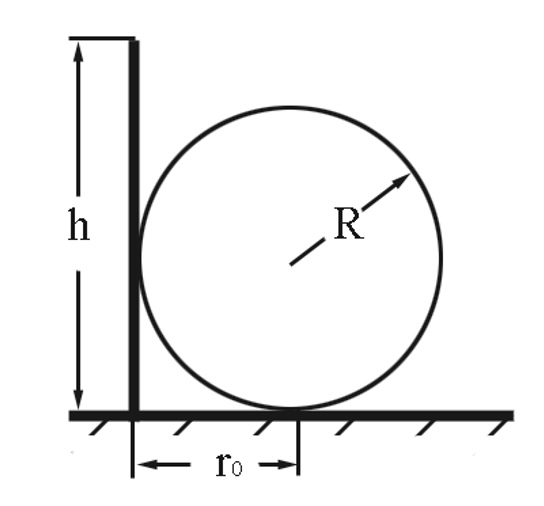
pace does not depend in any way on the lightning arrester's height, if its height h exceeds the rolling sphere radius R. For protection level I R = 20 m. According to the IEC, lightning arresters higher than 20 m do not make sense. It is hard to believe even for an ancient graduate of a church school.
One more figure from the IEC standard. The building is protected if, supported by
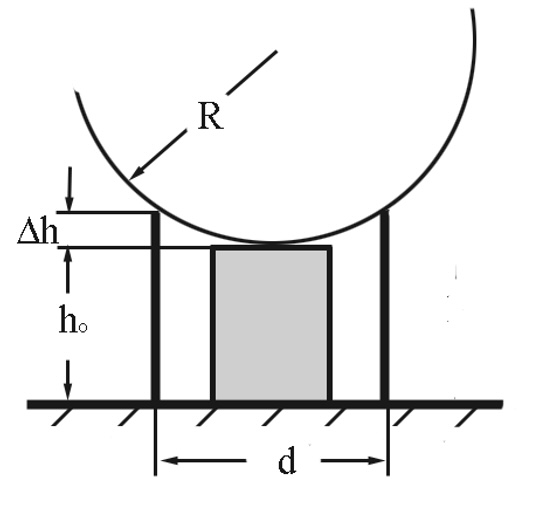
lightning arresters, the sphere does not touch the building roof. It means that lightning arresters may be considered as a dual structure only at distance d <2R. In this case, the height of lightning arresters is of no significance. Therefore, the design practice excludes not only dual but also repeated lightning arresters which are the most efficient in operations. The list of such drawbacks may be continued but it is better for the reader to see the proceedings of workshops by ZANDZ. They are analyzed in much details there. The workshops also consider the problems associated with the protective angle method. But one essential slip should be noted still. The provided figure was taken from the IEC standard. It demonstrates
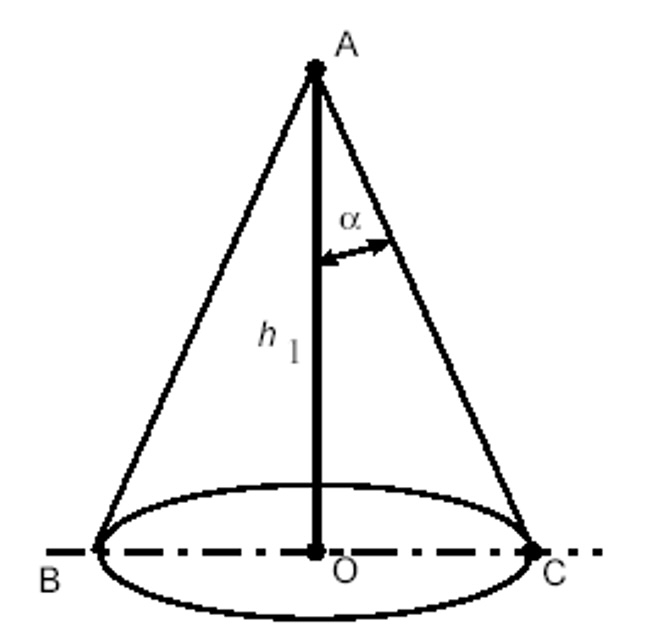
the protection zone that starts from the lightning arrester's top. No particular elevation of the lightning arrester above the facility is required. This article has already discussed this essential slip.
I've managed to read the translation of the next volume of the IEC standard devoted to calculation of lightning arresters, which preserved all of the above. Seems like it doesn't really cause confusion for Gosstandard who wants to publish it as GOST R. We can only rely on the European sanctions, although it is better to rely upon a demanding attitude of the Russian designers to the regulatory documents for lightning protection.
In substitution of the conclusion
Can we think of studied statistics software as a perfect tool to perform design calculations for lightning arresters? Certainly, not. Its methodological basis is non-specific for the lightning current. It is forcedly based on a limited dataset of lightning parameters known today to the world specialists' community. These data are being collected slowly and unfortunately not for the conditions most often needed by the designer. Nearly all oscillographic lightning current records are made on high-rise structures. There is a much higher chance for success in this case due to an increased frequency of lightning current strikes. But these are very different lightnings. Their parameters significantly differ from the lightnings striking the structures of a normal height. But engineers have to work with them most often. The typical height of HVPL supports of industrial or civil construction rarely exceed several dozens meters, and therefore they are not often affected by lightnings. They are almost not suitable for creating points for oscillographic records of lightning currents. There is an old story about a poor man who lost his keys near a beer shop and was looking for them in the bus stop where there's more light. Looks like this story is still relevant in lightning protection.
Current is the main effect of the lightning. The protective effect of the lightning arrester should be defined not for the lightning in general but for the lightning having a particular current and particular time parameters dangerous for the protected facility. This area of improvement of the calculation technique is the most relevant. We cannot avoid studying it just as we cannot avoid mass records of lightning currents at the facilities of normal heights using modern digital methods. Today, we have to use the developed technique non-specific to the lightning current and clearly understand that the statistical approach at least allows avoiding unjustified reserves in terms of numbers and height of lightning arresters, which are caused by the use of protection zones.
Appendix
The methodological basis of software is provided below to calculate the protective effect of a system of lightning arresters of an arbitrary design.
- When the lightning channel starts in the thundercloud, in the beginning of its path, it is formed without any response to the conditions of the ground surface and protected structures located thereon. This happens until a head of the lightning channel goes down to a certain height which is called the orientation height Нo. The probability of the presence of a channel head is equal for any location of the orientation plane.
- Starting from level Ho, the orientation process begins, which determines the probability of the lightning development to the "lightning arrester/facility" system rather than to the undisturbed ground surface. These two completely different directions can consider the formation of plasma channels without a mutual influence, and therefore, mathematical formalism (1)-(5) provided in this article can be entirely used to describe the probability of these events.
- Great length of discharge gaps from the lightning channel head at the orientation height to the ground and to the lightning arrester's top allows using equal average values of breakthrough voltage Eпр.

(P1)
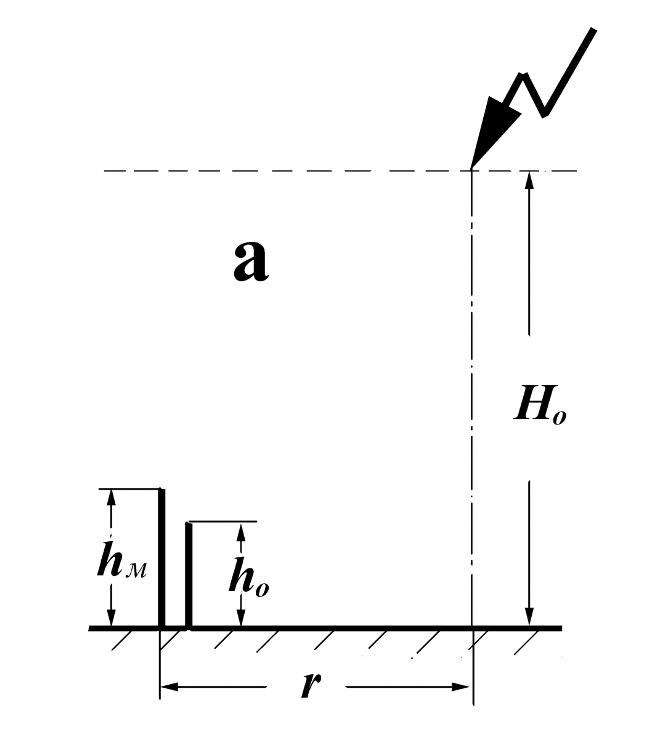
As a result, the upper limit of the probability integral in equation (4) provided in the article can be represented as:

(P2)
where r – is a radial offset of the lightning channel head in the orientation plane relative to the vertical axis of the lightning arrester σ% - is a dispersion standard of breakthrough voltages of a single gap many meters long, expressed as % of the average value. In this case, the orientation probability is presented as an already used probability integral:

(P3)
easily calculated and even provided in the reference book tables.
- Striking point is chosen on the surfaces of the lightning arrester and the protected facility by competitive development of opposed leaders from their tops. This process is also statistical in terms of all physical events but it is much more determined due to mutual influence through an electrical field. Thus, e.g. some of starting opposed leaders accidentally leapfrogging other leaders weakens the electrical field in the location of lagging leaders by its volume charge, which leads to their deeper growth retardation. Detailed laboratory research in long gaps have shown that the appearing effect of positive feedback can be formally considered in an algorithm proposed to calculate the orientation process, if we introduce a new statistical parameter, choice standard σо instead of dispersion standard σвыб, in which case the closer the lightning arrester and the protected facility to each other, the lower the value of so. As a result, for the strike point choice probability for the protected facility, we can generate a calculation expression which is similar in its structure to (P1)-(P2).

(P4)

(P5)
Выб - ch
Here,

(P6)
- - the shortest distance from the lightning channel head at the orientation height to the top of the lightning arrester having height of hM;

(P7)
the similar distance to the facility having the height of ho at the distance between the facility and the lightning arrester equal to а.
The lightning with the head position in the orientation plane characterized by coordinate r, will break through to the protected facility with the probability of

(P8)
Thus, to determine the complete number of breakthroughs, it is sufficient to integrate F(r) for the entire orientation plane by multiplying the integration result to the specific density of lightning discharges in the considered territory nM. Thus, in case of a radial symmetry

(P9)
The algorithm similar to the provided one can be extended to an arbitrary number of lightning arresters and facilities of various configurations and heights, if, at each calculation step, we use shortest distances from the lightning channel head with the specified coordinates in the orientation plane to the considered set of lightning arresters and to the set of protected facilities, and integrate in (P9) in a general case using Cartesian axials.
The value of the dispersion standard, as it was already noted, is much less than the orientation standard due to mutual influence of discharge processes in elementary gaps of a multi-electrode system. Due to this influence that strengthens any random statistical variation, the choice becomes more determined. As a result, upon reduction of the distance between the tops of the grounded electrodes (e.g. between a lightning arrester and a facility), the value σвыб is reduced. Actually, σвыб should be considered as a main fitting parameter in the statistical technique. To refine it, calculated breakthrough probabilities were compared with the operating experience of HVPL of various voltage classes as well as with distributions of lightning charges along the external structures of high-rise facilities such as Ostankino TV Tower.
5. Initial calculation parameters
Orientation standard σо as it was already noted, characterizes the dispersion of breakthrough voltages of air gaps of many dozens meters long upon exposure of voltage pulses with the front having a duration of several milliseconds. Based on tests of such gaps, it was assumed σо = 0,1 which is more than enough.
Choice standard σch depends on the distance between the lightning arrester and the protected facility. To generate this dependence, data on lightning strikes to various points along the Ostankino TV Tower height and operating experience of HVPL wire lightning arresters were used. The result was an empirical formula
σch = 7×10-3 + 8×10-5D,
where D is the shortest distance between the lightning arrester and the facility.
Orientation height Ho was based on an assumption that the radius of attraction of lightnings to the facility having h is equal to R(h) = 3h, which leads to the following expression using geometrical constructions:
Ho = 5h

